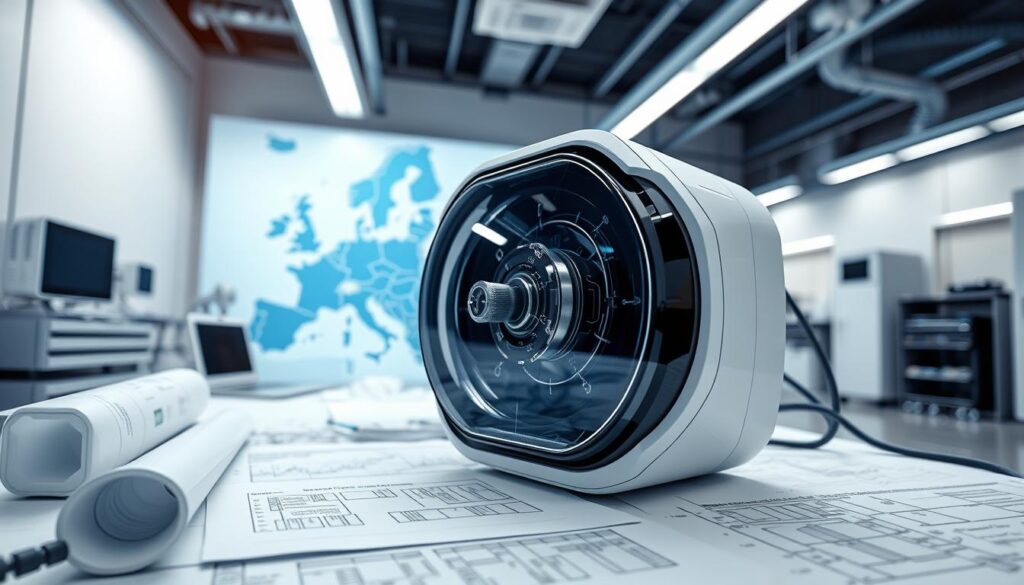The European Commission has released a Q&A document on the implementation of Regulation (EU) 2023/607. This regulation updates the Medical Device Regulation (MDR) and In Vitro Diagnostic Medical Devices Regulation (IVDR)1. It extends the MDR transitional period and removes ‘sell-off’ periods for certain devices1.
The document offers guidance on the amendment’s practical aspects. It covers scope, evidence needs, and conditions for extended transitional periods. It also talks about the role of notified bodies in surveillance1.
The MDR brings big changes to medical device rules in Europe, replacing old Directives2. It impacts the whole life cycle of medical devices. This includes clinical studies, market entry checks, and post-market rules.

Key Takeaways
- Regulation (EU) 2023/607 extends the MDR transitional period and removes the ‘sell-off’ periods for certain medical devices.
- The Q&A document provides guidance on practical aspects of the amendment, including scope, evidence requirements, and transitional period conditions.
- The MDR replaces the previous Medical Device Directives, introducing significant changes to the medical device lifecycle.
- The MDR affects various aspects of medical devices, including clinical investigations, market entry assessment, and post-market requirements.
- The Q&A covers aspects like certification requirements, national derogations, device classifications, and evidence of extended transitional periods.
Understanding the MDR Transition Period Extensions
The EU Medical Device Regulation (MDR) started in May 2021, replacing the old Medical Device Directive (MDD)3. Companies could renew their MDD certificates, giving them more time to meet MDR standards by 20243. Even with these extensions, they must still follow post-market rules, like PMCF activities3.
These activities include clinical trials and surveys to check how devices work3. Companies must choose which devices to focus on for PMCF, based on sales and when certificates expire3. They also need to make sure the data supports the device’s use and benefits3.
Key Changes in Transitional Provisions
The IVDR transition only helps legacy devices, not new ones without an IVDD CE mark by May 26, 20224. All legacy IVDs must have a new quality system by May 26, 20254. Companies can sell these devices until 2025 with an IVDD CE mark, but they must follow some IVDR rules4.
Impact on Legacy Devices
Companies making legacy devices don’t have to fix all quality system issues right away4. They only need to address certain issues based on the device’s legacy status4. Devices with MDD certificates are watched closely, but self-declared devices are not4.
Timeline Extensions for Different Device Classes
High-risk devices (class III and class IIb implantables) have until December 31, 2027, to switch to MDR3. Other devices have until December 31, 20283. Custom-made devices also get more time3. Companies must apply and agree with a notified body to get this extra time3.
Many MDD certificates will expire in 2024, causing delays in reviews3. It’s best to comply early to avoid problems3.
“The transition from MDD to MDR (EU) 2017/745 presents various challenges for manufacturers and notified bodies, including the need for additional expertise and increased resources.”5
| SUBJECT | Article 120 Regulations EU MDR History PDF |
| FILE TYPE | |
| LANGUAGE | ENGLISH |
| FILE SIZE | 201 kb |
| NO OF PAGES | 21 |
Article 120 Regulations EU MDR History PDF Requirements and Documentation
The Medical Device Regulation (MDR) brought big changes to medical devices in the European Union (EU)6. It has a transition period for companies to follow the new rules step by step6. This part talks about the updates to technical documents, how to integrate quality management systems, and the need for notified body checks under Article 120 of the MDR.
Technical Documentation Updates
Companies making medical devices need to update their technical documents to meet the MDR’s stricter rules7. They must include detailed info on the device’s design, risks, and clinical tests7. These updates help make sure old devices meet the new rules before they can be sold or used.
Quality Management System Integration
The MDR says companies must link their Quality Management System (QMS) with the new rules in Article 10(9)7. By May 26, 2024, they must have a QMS that covers all MDR rules, like monitoring after sale, reporting problems, and using Unique Device Identification (UDI) systems7.
Notified Body Surveillance Requirements
During the transition, notified bodies are key for checking medical devices7. They make sure old devices are watched over, possibly by moving the watch from a previous MDD/AIMDD body to an MDR one7. The movie must include the watch details when it will happen, and who does what.
| Key Regulatory Dates and Requirements |
|---|
| –7 Prior to 26 May 20217, 100% of legacy devices were covered by a certificate issued by a notified body. |
| –7 Before 26 May 20217, 100% of legacy devices required the involvement of a notified body in the conformity assessment procedure. |
| –7 From 25 May 2017 to 26 May 20217, the (AI)MDD certificate needed to be valid for legacy devices to be placed on the market or put into service. |
| –7 No later than 26 May 20247, manufacturers must have put in place a Quality Management System (QMS) according to Article 10(9) MDR. |
| –7 By 26 May 20247, manufacturers must have lodged an application for Conformity Assessment Procedure (COP) of the device or a substitute device. |
| –7 By 26 Sept 20247, manufacturers must have concluded an agreement with a Notified Body (NB). |
These rules and deadlines show how big the change is for medical device makers6. It’s key to plan well and act fast to follow the new MDR rules6.

Device Certification and Market Access Changes
The Medical Device Regulation (MDR) brought big changes to how medical devices are certified and sold in the European Union (EU)8. Before the MDR, devices were certified under less strict rules. The need for better safety led to the new rules8.
Now, before devices are certified, they must meet the new MDR standards and get a new CE mark9. Manufacturers must know the difference between “substantial” and “significant” changes to their devices. This affects if a device needs new certification9. The MDR also makes clinical tests more strict, especially for high-risk devices8.
Also, the MDR now includes more products, like non-corrective contact lenses, in its scope8. Software, health apps, and medical devices using machine learning are now part of the definition. This shows how healthcare technology is changing8. Manufacturers must follow the MDR’s surveillance rules from May 26, 2020, for all devices8.
The MDR’s rules are being rolled out over time, with some devices getting more time to adjust6. This gives manufacturers more time to make sure their devices meet the new standards. It keeps patient safety the main goal6.

Understanding the MDR’s new rules is key for manufacturers6. They need to review their products, update their documents, and work with Notified Bodies. This ensures a smooth transition and keeps devices on the market6.
Conclusion
The Medical Device Regulation (MDR) is a big change in Europe. It makes rules for technical documents, quality systems, and more10. Manufacturers have more time to get ready, but they must follow certain rules11.
This change affects many, like makers, bodies, and health places. It’s key to keep medical devices safe and working well in Europe12.
With many AIMDD/MDD certificates set to expire, and over 500,000 devices needing a change, action is needed12. This is to keep medical devices flowing in Europe.
Article 120 regulations EU MDR history pdf and medical device regulation Europe offer important info. By keeping up and acting fast, makers can meet new safety and performance standards in Europe.
FAQ
What is the Article 120 Regulations EU MDR?
The Article 120 Regulations EU MDR is a change to the Medical Device Regulation (MDR) and In Vitro Diagnostic Medical Devices Regulation (IVDR). It extends the MDR’s transition period. It also removes ‘sell-off’ periods for certain medical devices.
What are the key changes in the MDR transitional provisions?
The MDR transitional provisions have seen key changes. The period for certain devices has been extended. Class III and class IIb implantables now have until December 31, 2027. Other devices have until December 31, 2028.
Custom-made devices also get an extension. But, manufacturers must meet certain conditions to benefit.
How does the MDR amendment impact legacy devices?
Legacy devices can still be sold under old rules if their certificates were issued before May 26, 2020. No major changes to the device’s design or purpose are allowed. Manufacturers must follow specific rules to keep selling these devices.
What are the technical documentation and quality management system requirements under the MDR?
Manufacturers must update their technical documents to meet the MDR’s new standards. This includes detailed information on design, risk management, and clinical evaluation. The Quality Management System (QMS) must also align with the MDR, covering aspects in Article 10(9) MDR.
What are the notified body surveillance requirements during the MDR transitional period?
Notified bodies must watch over devices during the transition. They might need to switch from MDD/AIMDD to MDR-designated bodies. The transfer plan should outline the surveillance scope, timelines, and roles of both bodies.
What are the key changes in device certification and market access under the MDR?
Existing devices (“legacy devices”) must now meet the MDR’s standards and get CE marked again. Manufacturers must start MDR post-market surveillance from May 26, 2020. The MDR now covers more products, like non-corrective contact lenses.
Source Links
- https://health.ec.europa.eu/document/download/592008f6-3456-4afb-a13a-733a87da1b00_en?filename=mdr_proposal_extension-q-n-a_1.pdf – PDF
- https://pmc.ncbi.nlm.nih.gov/articles/PMC9395138/ – The European Medical Device Regulation–What Biomedical Engineers Need to Know
- https://ondrugdelivery.com/wp-content/uploads/2022/02/129_2022_Feb_PFS_RQM_Plus.pdf – PDF
- https://www.linkedin.com/pulse/eu-releases-qa-document-ivdr-transition-period-extension-qie0c – EU releases Q&A document on IVDR transition period extension and MDR transition period extension Q&A document update
- https://www.tuv-nord.com/fileadmin/user_upload/TUEV_NORD_MDR_including_M3.pdf – TÜV NORD MDR including M3
- https://www.intertek.com/assurance/mdr/ – MDR Certification | EU Medical Device Regulation 2017/745
- https://health.ec.europa.eu/system/files/2023-08/md_devices-art120_flowchart_0.pdf – PDF
- https://pmc.ncbi.nlm.nih.gov/articles/PMC7096591/ – Changing Device Regulations in the European Union: Impact on Research, Innovation and Clinical Practice
- https://decomplix.com/medical-device-significant-changes/ – Guidance on medical device significant changes under MDR
- https://www.dgra.de/media/pdf/fortbildung/kongresse/2018/kongress2018-08-edelhaeuser.pdf – 20th DGRA Annual Congress – Medical Device Regulation
- https://www.zora.uzh.ch/id/eprint/253237/1/ZORA_pdf.pdf – The medical device regulation (MDR) from a dental perspective
- https://www.iconplc.com/insights/blog/2022/11/30/mdr-certification-bottleneck – MDR certification bottleneck | ICON plc
